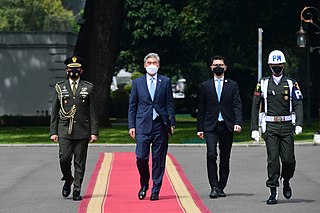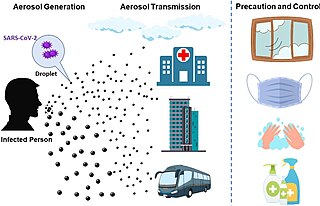Related Research Articles

Lysol is a brand of American cleaning and disinfecting products distributed by Reckitt, which markets the similar Dettol or Sagrotan in other markets. The line includes liquid solutions for hard and soft surfaces, air treatment, and hand washing. The active ingredient in many Lysol products is benzalkonium chloride, but the active ingredient in the Lysol "Power and Free" line is hydrogen peroxide. Lysol has been used since its invention in the late 19th century as a household and industrial cleaning agent, and previously as a medical disinfectant.
A virucide is any physical or chemical agent that deactivates or destroys viruses. The substances are not only virucidal but can be also bactericidal, fungicidal, sporicidal or tuberculocidal.

In health care facilities, isolation represents one of several measures that can be taken to implement in infection control: the prevention of communicable diseases from being transmitted from a patient to other patients, health care workers, and visitors, or from outsiders to a particular patient. Various forms of isolation exist, in some of which contact procedures are modified, and others in which the patient is kept away from all other people. In a system devised, and periodically revised, by the U.S. Centers for Disease Control and Prevention (CDC), various levels of patient isolation comprise application of one or more formally described "precaution".

The COVID-19 pandemic, also known as the coronavirus pandemic, is a global pandemic of coronavirus disease 2019 (COVID-19) caused by severe acute respiratory syndrome coronavirus 2 (SARS-CoV-2). The novel virus was first identified in an outbreak in the Chinese city of Wuhan in December 2019. Attempts to contain it there failed, allowing the virus to spread to other areas of Asia and then worldwide in early 2020. The World Health Organization (WHO) declared the outbreak a public health emergency of international concern (PHEIC) on 30 January 2020. The WHO ended its PHEIC declaration on 5 May 2023. As of 14 November 2023, the pandemic had caused 771,820,173 cases and 6,978,162 confirmed deaths, ranking it fifth in the deadliest epidemics and pandemics in history.

Coronavirus disease 2019 (COVID-19) is a contagious disease caused by the virus SARS-CoV-2. The first known case was identified in Wuhan, China, in December 2019. The disease quickly spread worldwide, resulting in the COVID-19 pandemic.

False information, including intentional disinformation and conspiracy theories, about the scale of the COVID-19 pandemic and the origin, prevention, diagnosis, and treatment of the disease has been spread through social media, text messaging, and mass media. False information has been propagated by celebrities, politicians, and other prominent public figures. Many countries have passed laws against "fake news", and thousands of people have been arrested for spreading COVID-19 misinformation. The spread of COVID-19 misinformation by governments has also been significant.

In Lebanon, the worldwide pandemic of coronavirus disease 2019 (COVID-19) caused by severe acute respiratory syndrome coronavirus 2 has resulted in 1,238,552 confirmed cases and 10,936 all-time deaths after COVID-19 was confirmed to have reached Lebanon in February 2020.

The COVID-19 pandemic in Turkey is part of the ongoing pandemic of coronavirus disease 2019 caused by severe acute respiratory syndrome coronavirus 2.

The COVID-19 pandemic in Montenegro has resulted in 251,280 confirmed cases of COVID-19 and 2,654 deaths.

The COVID-19 pandemic in Ghana was a part of the worldwide pandemic of coronavirus disease 2019 caused by severe acute respiratory syndrome coronavirus 2. The first two cases in Ghana were confirmed on 12 March 2020, when two infected people came to Ghana, one from Norway and the other from Turkey.

Hazard controls for COVID-19 in workplaces are the application of occupational safety and health methodologies for hazard controls to the prevention of COVID-19. Vaccination is the most effective way to protect against severe illness or death from COVID-19. Multiple layers of controls are recommended, including measures such as remote work and flextime, increased ventilation, personal protective equipment (PPE) and face coverings, social distancing, and enhanced cleaning programs.

During the COVID-19 pandemic, face masks or coverings, including N95, FFP2, surgical, and cloth masks, have been employed as public and personal health control measures against the spread of SARS-CoV-2, the virus that causes COVID-19. With the progress of the pandemic, the public interest in face masks as a means of protection was greatly increased, often even before governments implemented mandatory mask-wearing.

The COVID-19 pandemic in the Cordillera Administrative Region is part of the worldwide pandemic of coronavirus disease 2019 caused by severe acute respiratory syndrome coronavirus 2. The virus reached the Cordillera Administrative Region on March 20, 2020, when the first case of the disease was confirmed to involve a resident of Manabo, Abra. All provinces, as well as the independent city of Baguio has recorded at least one confirmed COVID-19 case.
Diving equipment may be exposed to contamination in use and when this happens it must be decontaminated. This is a particular issue for hazmat diving, but incidental contamination can occur in other environments. Personal diving equipment shared by more than one user requires disinfection before use. Shared use is common for expensive commercial diving equipment, and for rental recreational equipment, and some items such as demand valves, masks, helmets and snorkels which are worn over the face or held in the mouth are possible vectors for infection by a variety of pathogens. Diving suits are also likely to be contaminated, but less likely to transmit infection directly.

The transmission of COVID-19 is the passing of coronavirus disease 2019 from person to person. COVID-19 is mainly transmitted when people breathe in air contaminated by droplets/aerosols and small airborne particles containing the virus. Infected people exhale those particles as they breathe, talk, cough, sneeze, or sing. Transmission is more likely the closer people are. However, infection can occur over longer distances, particularly indoors.

Part of managing an infectious disease outbreak is trying to delay and decrease the epidemic peak, known as flattening the epidemic curve. This decreases the risk of health services being overwhelmed and provides more time for vaccines and treatments to be developed. Non-pharmaceutical interventions that may manage the outbreak include personal preventive measures such as hand hygiene, wearing face masks, and self-quarantine; community measures aimed at physical distancing such as closing schools and cancelling mass gathering events; community engagement to encourage acceptance and participation in such interventions; as well as environmental measures such surface cleaning. It has also been suggested that improving ventilation and managing exposure duration can reduce transmission.
Accelerated hydrogen peroxide (AHP) is a trademark for solution of hydrogen peroxide whose antibacterial efficacy is enhanced by a surfactant and an organic acid. It is also a disinfectant/cleaning agent that stabilizes hydrogen peroxide so that it can be used for extended periods of time.
A deep clean, in the context of the COVID-19 pandemic, is a sanitation technology. It can mean different things, depending on the industry or jurisdiction. For example, the UK NHS care home guidelines differ from the US CDC recommendations on "How to clean and disinfect". The EPA has created a COVID-specific webpage on which are listed disease-specific pesticidal disinfectants, and has created a webpage on "GUIDANCE FOR CLEANING AND DISINFECTING" in the context of the April 2020 plan, "Opening Up America Again".
Misinformation related to the COVID-19 pandemic in the Philippines consists of disinformation about the COVID-19 pandemic propagated by various sources.

Zero-COVID, also known as COVID-Zero and "Find, Test, Trace, Isolate, and Support" (FTTIS), was a public health policy implemented by some countries, especially China, during the COVID-19 pandemic. In contrast to the living with COVID-19 strategy, the zero-COVID strategy was one "of control and maximum suppression." It involved using public health measures such as contact tracing, mass testing, border quarantine, lockdowns, and mitigation software in order to stop community transmission of COVID-19 as soon as it was detected. The goal of the strategy was to get the area back to zero new infections and resume normal economic and social activities.
References
- 1 2 3 Thompson, Derek (July 27, 2020). "Hygiene Theater Is a Huge Waste of Time". The Atlantic . Archived from the original on April 8, 2021. Retrieved February 22, 2021.
- 1 2 Thompson, Derek (February 8, 2021). "Hygiene Theater Is Still a Huge Waste of Time". The Atlantic. Retrieved February 22, 2021.
- 1 2 3 Landsverk, Gabby (October 14, 2020). "5 bogus coronavirus protection measures that are just 'hygiene theater' — and 2 things that actually do work". Insider . Retrieved February 22, 2021.
- ↑ Palumbo, Alysha (November 24, 2020). "Is Deep Cleaning Just 'Hygiene Theater' in the Age of COVID?". WBTS-CD . Retrieved February 22, 2021.
- 1 2 Thorbecke, Catherine; Lambert, Alexandra (September 20, 2020). "'Hygiene theater': Disinfecting sprays and sanitizing robots alone won't keep you safe from COVID-19". ABC News . Retrieved February 22, 2021.
- ↑ Ives, Mike; Mandavilli, Apoorva (November 19, 2020). "The Coronavirus Is Airborne Indoors. Why Are We Still Scrubbing Surfaces?". The New York Times . ISSN 0362-4331 . Retrieved February 22, 2021.
- 1 2 Anthes, Emily (April 8, 2021). "Has the Era of Overzealous Cleaning Finally Come to an End? -- This week, the C.D.C. acknowledged what scientists have been saying for months: The risk of catching the coronavirus from surfaces is low". The New York Times. Archived from the original on April 8, 2021.
- ↑ "Pandemic Travel Buzzwords We Hope Get Left Behind in 2020" Skift.com. Retrieved 2022-01-16.
- ↑ "Word of the week: Hygiene theater" Fritinancy. Retrieved 2022-01-16.
- ↑ "Apr 28th, 2020 | Tom Talks". April 28, 2020.
- ↑ Lewis, Dyani (January 29, 2021). "COVID-19 rarely spreads through surfaces. So why are we still deep cleaning?" . Retrieved April 10, 2021.
- 1 2 3 Fisher, Marc (June 14, 2021). "Temp checks, digital menus and 'touchless' mustard: The maddening persistence of 'hygiene theater'". Washington Post. ISSN 0190-8286 . Retrieved June 14, 2021.